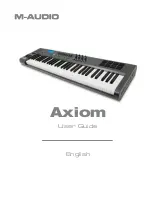
9-12
Effects and Effect Mode
Effects Overview
Effects Parameters
This section contains descriptions of the PC3A’s many effects parameters, and instructions on
how to use them. Read through this section to get a good general understanding of the
parameters.
The descriptions here do not include all of the parameters associated with every effect, and some
effects may not have some of the parameters described here for their category. A more complete
reference, with every effect and the meaning and range of every parameter, arranged in the order
they appear on the screen, can be found in the
KSP8 Algorithm Reference Guide
on the Kurzweil
website, www.kurzweil.com.
General Parameters
There are a number of parameters that are common to all or almost all effects, and we’ll deal with
those
first.
Wet/Dry
balances the levels of the processed and unprocessed signals output from the effect. Wet
represents the processed signal, while dry represents the unprocessed signal. The range is 0%
wet (the signal is unprocessed) through 100% wet (no dry signal is present). Values between 0%
and 100% blend the two signals, for example, at 20% the output signal is 20% wet (processed) and
80% dry (unprocessed.) A setting of 50% wet means the dry and processed signals are roughly
equal in level. In some effects, separate Wet/Dry parameters are provided for the Left and Right
input channels. In some cases, this parameters can have negative values, which indicate that the
Wet signal is polarity-inverted.
When an effect with the Wet/Dry parameter is used in Chain that has been selected as an Aux
effect, Wet/Dry is automatically set to 100% wet and cannot be adjusted. This is because when
using an Aux effect, the dry signal is already effectively at 100% on the main audio bus (not
routed through the Aux effect.) In this case, turning up the Aux send level will blend the 100%
wet signal (from the Aux bus) with the dry signal on the main audio bus.
Out Gain
sets the gain at the output of an effect.
In/Out
enables or disables the effect. You can think of it as a Wet/Dry parameter with only two
positions: 100% (In) and 0% (Out).
HF Damping
(high frequency damping) is the cutoff (-3 dB) frequency of a 6dB/octave lowpass
filter that’s inserted before the processor. High frequencies above the set cutoff frequency will be
filtered out. In the case of processors where multiple iterations of the signal are heard, such as in a
delay, each iteration of the signal will pass through the filter, and will therefore be duller.
XCouple
(Cross Couple). In stereo effects, this controls how much of any signal being fed back is
going to the channel
opposite
to the one where it first appeared. At 100%, all feedback from signals
at the left input goes to the right channel and vice versa, causing a “spreading” or in the case of
delay lines, a “ping-pong” effect. At 0%, fed-back signals stay with the channel they came in on.
A->B cfg
(configuration). In combination effects that contain two (or more) components, the
order in which the signal passes through the two components can be changed with this
parameter. Combination effects are usually named with a “->”, as in 484 “Flange->Shaper”. For
example, 484 “Flange->Shaper” can be configured so the signal passes through the flanger first
and then the shaper, or through the shaper first and then the flanger. The
cfg
parameter
determines the configuration, and its value is context-sensitive—in this example, the choices
would be “Fl->Shp” and “Shp->Fl”.
A/Dry->B
is also found in many combination effects, and controls the amount of signal that will
pass dry (unprocessed) through the first component into the second component. Different
combination effects use different variations on this parameter, depending on the context. The
range is 0 to 100%.
















































